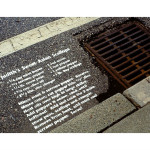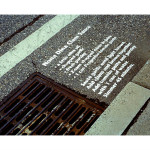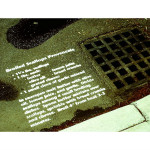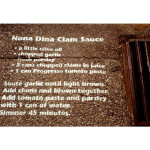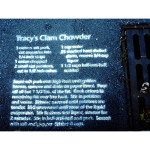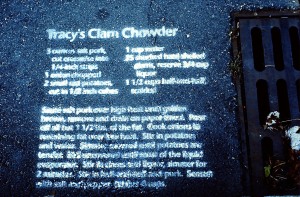- Recipe/Storm Drain Stenciling Project
- Recipe/Storm Drain Stenciling Project
- Recipe/Storm Drain Stenciling Project
- Recipe/Storm Drain Stenciling Project
- Recipe/Storm Drain Stenciling Project
In the Recipe/Storm Drain Stenciling Project family recipes from local neighborhoods are stenciled next to storm drains to highlight the direct connection between the storm drains, local waterways, and our food supply.
(This piece was made possible in part from a Rhode Island Sea Grant.)

The project's informational flyer
Coming to a storm drain near you…
Did you know that:
- Americans carelessly dispose of 385 million gallons of oil each year? That is 35 times more oil than was spilled in the entire Exxon Valdez oil spill. At least half of that is improperly disposed of by do-it-yourself oil changers.
- One gallon of used oil can create an eight-acre slick on surface water, threatening fish, waterfowl, and other aquatic life?
- Used antifreeze, which is itself poisonous to people and pets, also contains heavy metal contaminants which it pick up from the engine during use?
- Soap suds from washing your car, rinse water from painting, pet waste, pesticides, plastics and yard waste can all cause environmental problems when disposed of in storm drains?
- The practice of pouring wastes down storm drains has a direct and severe impact on the environment?
While these facts may be tough to swallow, we in fact could be doing just that. The majority of storm drains in and around the Boston area release directly into local waterways which in turn drain into the Boston Harbor and the ocean beyond. At every stage these pollutants have increasing opportunities to enter our food chain. So is it that great a stretch to think, “From your storm drain to my dinner table”?
Dealing with the problem
And while these facts may seem overwhelming, we are on the verge of dealing with some of these problems on a massive scale. The Boston Harbor Project is well underway. The first half of the primary plant is targeted to be fully operational in 1995. Boston Water and Sewer continues to fix those pipes that combine street runoff and sewage and , as a result, release untreated waste into the harbor during heavy rains.
But these agencies are not able to handle the whole task alone. As the facts establish, the unregulated storm drains in every neighborhood represent a potential site for acute environmental pollution. If local waterways are to remain viable ecosystems the immediate community needs to watch out for their own neighborhoods. It is for this reason that we have initiated this project.
The Project
The purpose of this project is twofold:
- To educate and later remind people of the direct connection between storm drains, local waterways, and out food supply.
- Highlight the diversity of Boston’s families and our common dependence on the Boston Harbor and the ocean beyond.
To do this we will be stenciling next to storm drains family recipes that are based on an ingredient that could be or could have been harvested from the Boston Harbor.
It is our hope that the stenciling of family recipes will highlight the rich heritage of Boston’s diverse families and serve to remind us that our children will inherit both the culinary traditions and the food supply on which they are based. Protecting our waterways and the maritime life they support helps preserve these family traditions for future generations.
While this project will be done in cooperation with the Massachusetts Water resources Authority and the Boston Water & Sewer Commission, it is an independent community-based project that will reflect the voluntary efforts of individuals from the community.
A newspaper story about the project
Coming to a storm drain near you–seafood recipes
You have distant relatives coming into town from the Midwest, and they are eager to sample Boston’s seafood. Do you say, “quick honey, run out to the nearest storm drain and get a good recipe for clam chowder.”? Maybe you will, after Charles McQuillen completes his unique environmental art project in the summer of 1995.
McQuillen is a West Roxbury artist who says he “…usually creates environmental installations in the out-of-doors.” His works, he says, are “site-specific” and “integrate the materials at hand with natural processes to explore cycles, patterns and interactions within the environment.” McQuillen’s work has been displayed at some of the most attractive outdoor settings in New England: Shelburne Farms in Shelburne, VT; Crane Beach; Plum Island; and various state parks. This summer though, McQuillen’s work is coming to a street near you, and he wants your help in getting it there.
The U.S. Environmental Protection Agency, The Massachusetts Water Resources Authority and the Boston Water and Sewer Commission are cosponsoring a stenciling project to warn against dumping hazardous wastes into storm drains because the toxins eventually make their way to local waterways. Volunteers stencil the message, “Don’t Dump. Drains to Boston Harbor” next to storm drains in their neighborhoods. McQuillen wants to expand on that message and relate it more directly to the neighborhoods in which the stenciling occurs. He conceived of using family recipes in the stencils as a way of reminding people of the direct connection between storm drains, local waterways, and our food supply while highlighting the diversity of Boston’s families and our common dependence on the surrounding ocean.
Originally, McQuillen intended to cluster his recipe stencils in West Roxbury, but a “Sea Grant” will allow him to bring the project into more of Boston’s neighborhoods. The University of Rhode Island provides Sea Grants specifically for art projects that bring attention to the ocean. McQuillen says he still does not know exactly how many recipe stencils he will design for Boston. “That,” he says, “depends on the response from the neighborhoods.” He will stencil only in neighborhoods where the residents are receptive to the idea.
Meanwhile, McQuillen is starting now to collect the recipes which will later be stenciled in the neighborhoods of contributors. The only restriction on recipes is that they include an ingredient that could be harvested from Boston Harbor. They should also be as concise as possible so no one has to walk a mile to read a recipe. McQuillen is eager to hear from Boston residents who would like to have their neighborhood storm drain graced with a seafood recipe and is looking forward to seeing piles of good family recipes.
There are other ways for local residents to get involved with the project. McQuillen will take care of securing the required permits and permission, designing the stencils, and organizing the supplies. Besides recipe submission, he is also looking for volunteers to distribute flyers in the neighborhoods to be stenciled and remove litter around the storm drains.
Anyone interested in participating in this project in any way should write to McQuillen care of this newspaper at…
– Kuzmin, Joyce. “Coming to a storm drain near you–seafood recipes,”
Parkway and West Roxbury Transcripts.Boston, MA. March 8, 1995.
“The stenciled recipe project creatively considers human/environment interaction, land use and the self-interest of environmental stewardship. The placement of stenciled local recipes adjacent to storm drains demonstrates our reliance upon natural resources. Originally, in 1994, McQuillen’s site-specific project brought attention to the plight of the Boston Harbor. Working with the Departments of Facilities and Operations and many volunteers, this socially involved and environmentally aware project is re-created for the present exhibition in the Kingston campus of the University of Rhode Island.”
– Tolnick, Judith. The Visual Arts Program of Sea Grant Rhode Island: The First Ten Years.
University of Rhode Island, RI. July, 1998.
For me, one of the greatest challenges of community-based art is the community. You need to completely change the way you work. You need to build more time into your process to rally support and incorporate feedback. Beyond the usual art making process you have to factor in financing, the logistics and organization of supplies and people, and permits/permission from numerous stakeholders. The Recipe/ Storm Drain Stenciling Project only touched on these issues at the most cursory level, but it instilled in me a new respect for Christo’s installations. The Wikipedia profile of Christo and Jeanne-Claude provides an overview of the commitment, scale, and costs of their celebrated installations. It really is awesome to consider.
The Recipe/Storm Drain Stenciling Project offers an opportunity to explore socially active art.
- Analyze the pictures from the project and imagine you happened upon them as you walked down the street. What is your initial response to what you see?
- Compare the recipe stencils to the “Don’t Dump. Drains to Boston Harbor” stencils. What are the different merits of each approach?
- Read the flyer copy. How do the stencils and the flyer work together but address different needs in advancing the the mission of the project?
- Read the news article. Why are general news stories, as opposed to reviews by critics preferential to such art projects?
- How are the needs of socially active art different than art shown in an art gallery?
For a deeper understanding of social action art compare this project to the Stacking a Line installations which foster public awareness and discourse but not the same social actions goals.
Environmental art the educates and heals
If students are interested in environmental installations that foster social action, you may want to direct them to sustainable art. Some artists who not only educate the public about environmental issues, but work to heal the environment include Jane Ingram Allen, ATM and RiverCubes, Betsy Damon, Agnes Denes, Basia Irland, Patricia Johanson, Daniel McCormick and Mary O’Brien, Matthew Moore, Gregg Schlanger, and Susan Leibovitz Steinman
In addition to the the environmentally focused sustainable art, there are a growing number of initiatives that meld the arts and social action. Consider the Center for Artistic Activism and Dot to Dot. This article offers an overview of socially active art and the challenge of judging such art.

